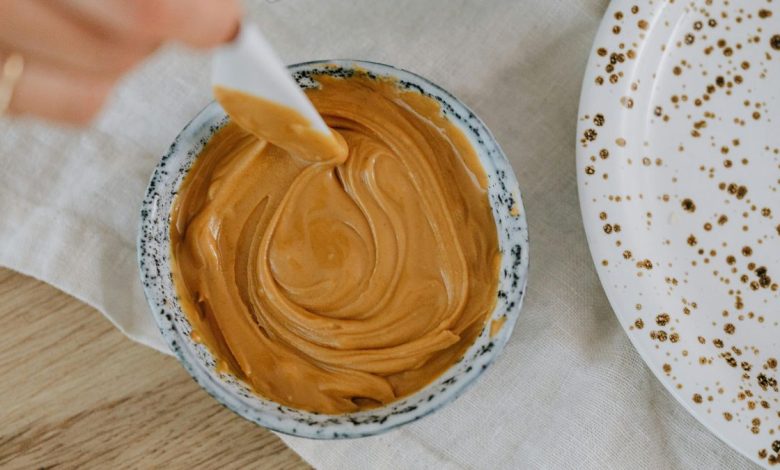How Long Does Peanut Butter Stay Fresh After Opening? Tips for Maximum Freshness

Peanut butter is a pantry staple loved for its creamy texture, nutty taste, and versatility. Whether spread on toast, blended into smoothies, or paired with fruit, it’s an easy-to-use ingredient. But like all foods, peanut butter has a shelf life, and knowing how long it stays fresh after opening is crucial to ensuring both its taste and safety.

How long does peanut butter stay fresh? Tips for maintaining its quality and the signs of spoilage to look out for.
How Long Does Peanut Butter Stay Fresh After Opening?
The shelf life of peanut butter varies based on the type you choose, whether conventional or natural. After opening, peanut butter’s freshness can be influenced by storage conditions, such as whether it is kept in a cool, dry place or refrigerated. Here’s what you need to know:
Conventional Peanut Butter:
Most standard peanut butters, which contain preservatives and stabilisers, can last 2 to 3 months in the pantry after opening. If you want to extend its freshness, refrigerating it can increase its shelf life to 6 to 9 months. In general, these peanut butters are more resistant to spoilage due to their added ingredients.
Natural Peanut Butter:
Natural peanut butter, which contains only peanuts (and sometimes salt), has a shorter shelf life. After opening, it can stay fresh in the pantry for 3 to 4 weeks. Refrigerating natural peanut butter is highly recommended, as it can keep for up to 3 to 4 months in the fridge. Without preservatives, natural peanut butter is more susceptible to spoiling.
ALSO READ: How To Prevent Your Avocado From Turning Brown
Storage Tips for Maximum Freshness
To make sure your peanut butter stays as fresh as possible, the way you store it matters. Whether you’re using conventional or natural peanut butter, proper storage helps retain its flavour, texture, and nutritional value. Here are a few tips to maximise its freshness:
1. Keep It Sealed
Ensure the lid is tightly secured after each use. This helps minimise air exposure, which can cause oxidation and accelerate spoilage. When air gets into the jar, it can cause the peanut butter to become rancid more quickly.
2. Use Clean Utensils
Always use clean spoons or knives when scooping out peanut butter. Introducing moisture or bacteria can lead to mould growth, especially in natural peanut butter. Keeping the jar clean and free from contamination will help prolong its shelf life.
3. Refrigerate for Longer Freshness
Refrigeration is a game-changer for extending the life of both conventional and natural peanut butter. While conventional peanut butter can last a bit longer without refrigeration, placing it in the fridge after opening will help preserve its flavour and texture for months. For natural peanut butter, refrigeration is a must for optimal freshness.
4. Store Upside Down (For Natural Peanut Butter)
If you buy natural peanut butter that has a tendency to separate (with oil floating on top), storing the jar upside down can help prevent the oil from separating. This ensures the peanut butter is evenly mixed and more manageable for spreading.
Signs of Spoilage: When to Toss Peanut Butter
Peanut butter can spoil, and it’s important to recognise the signs before consuming it. While it typically has a long shelf life, there are several key indicators to look out for to ensure your peanut butter is still safe to eat:
1. Off Smell
If your peanut butter smells rancid, sour, or “off,” it’s time to throw it away. Rancidity occurs when oils in the peanut butter break down, creating an unpleasant smell and taste.
2. Discolouration or Dry Texture
Peanut butter may darken slightly over time, but if it turns significantly darker or develops a dry, crumbly texture, it’s likely past its prime. A gritty texture or hard clumps may also indicate that it has gone bad.
3. Mould Growth
Mould can form in peanut butter, especially in natural peanut butter, if moisture is introduced. If you see any signs of mould, whether on the surface or within the jar, discard it immediately. Mouldy peanut butter should never be consumed.
ALSO READ: Intermittent Fasting Meal Prep: Where to Shop for Keto and Low-Carb Foods in Gauteng
Can Peanut Butter Go Bad?
While peanut butter has a relatively long shelf life, it does eventually lose its quality. Knowing how to store it and how to identify the signs of spoilage can help you avoid consuming peanut butter that’s no longer safe to eat. Keep in mind the type of peanut butter you’re using, and always check for any off smells, changes in texture, or mould before using it.
By following these simple tips, sealing the jar, using clean utensils, refrigerating when necessary, and watching out for spoilage signs, you can ensure that your peanut butter remains fresh for as long as possible.
Peanut butter remains fresh for a good period even after opening, but its longevity depends on the type and how you store it. Conventional peanut butter can last for months, while natural peanut butter has a shorter shelf life but can still last for a few months if refrigerated. Keep your peanut butter in optimal conditions to enjoy it at its best for as long as possible.
